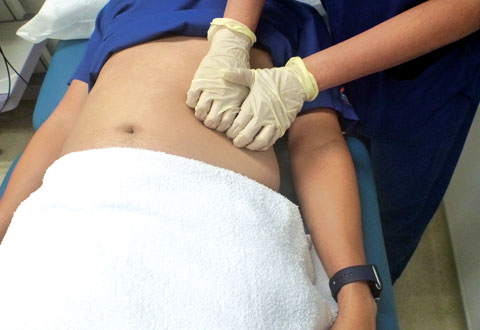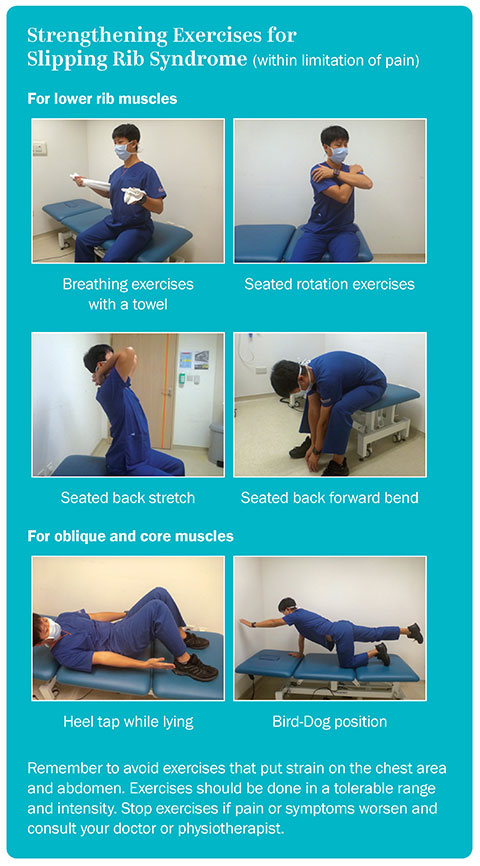Slipping rib syndrome is a rare condition
where the rib slips or moves, leading to
pain in upper abdomen or lower chest. The
condition often goes undiagnosed. Learn more from the National Heart Centre Singapore (NHCS).
Slipping rib syndrome is a rare condition where the rib slips or moves, leading to pain in upper abdomen or lower chest. The condition often goes undiagnosed1.
By Rachel Stephens, Physiotherapist, Department of Cardiac Physiotherapy Services
In slipping rib syndrome, the cartilage that holds the lower ribs to the ribcage becomes loose or slips, causing the rib attached to the cartilage to rub against the rib above or below it. This results in pain felt in the upper abdomen or in the chest as the increased movement tend to irritate the nerves of the ribcage2.
There is no definitive cause for slipping rib syndrome thus far, but in most cases, issues such as weakness in chest muscles or ligaments were usually evident. Those afflicted with this condition would often present with increased movement of the lower ribs. Other possible factors include chest wall anomalies since birth, injury to the cartilage of the ribs.
Even though the condition is rare, one can look out for these early signs and symptoms of slipping rib syndrome:
Intense pain in the lower chest or upper abdomen
A tender spot at the border of the rib, and reproduction of pain when pressing the tender spot
Pain may be present on both sides of ribs, but mostly occurs on only one side
Pain is often sharp in nature and can progress to a dull pain that can last for hours to week
Pain may travel from the ribs up to the shoulder blade
Worsening of pain with certain movements such as stretching, twisting the trunk, bending, carrying heavy loads
Worsening of pain when doing sports such as swimming, horseback riding and running, which involve the abdomen and heavy breathing
First Rare Case in NHCS
The Cardiac Physiotherapy Department saw its first case of slipping rib syndrome in 2021 that was referred from Asst Prof Soo Ing Xiang, Consultant with the Department of Cardiothoracic Surgery.
The patient, a female in her 20s, Ms Alice Chan*, was referred for therapy for a pain in her abdomen area. It was a unique and unexpected case, as the department generally sees more senior patients and mainly for heart or lung conditions.
Ms Chan complained of suffering from pain at the lower ribs on both sides for weeks and the pain had become more constant. She experienced pain when performing exercises which required use of the core muscles or bending forward, and that the pain was intense and caused a burning sensation.
Based on the preliminary information provided by the patient, the team of physiotherapists conducted a “Hook Manoeuvre”, a simple diagnostic test to assess if the patient was experiencing slipping rib syndrome3.
The Hook Manoeuvre Test

A ‘Hook Manoeuvre’ can test whether a patient is suffering from slipping rib syndrome.
First, the patient is required to lie flat on his/her back. The physiotherapist will place her fingers along the edge of the last rib and lift upwards and towards the head of the patient.
If this movement causes the patient to experience the same sharp pain or produce a “pop” sound as the rib moves, then the patient is confirmed to be having slipping rib syndrome. The test is highly sensitive and is the only test that can provide an accurate diagnosis of slipping rib syndrome.
Ms Chan was subsequently tested positive to have slipping rib syndrome, as she experienced pain in the right lower rib, and a “pop” sound could be heard in the left lower rib. She was also having pain in both the lower ribs upon rubbing the rib joint.
Personalised Treatment Plan & Exercise Programme
As slipping rib syndrome is usually a result of increased movements of the rib, it is important to strengthen the muscles around the ribs to reduce the movement of the rib and stabilise it.
Upon diagnosis, the patient was provided with a comprehensive treatment plan that includes pain management (such as medications and heat/ cooling therapy) and an exercise programme to strengthen rib and oblique muscles. Ms Chan was advised to rest and avoid strenuous activities so as to avoid any strains on the chest area and abdomen. She was also encouraged to do simple stretching and rotation exercises at home as per instructions given by the therapists. Through the exercise programme, she was guided with simple and easier exercises starting with sitting position to minimise pain, and thereafter gradually progressing to standing position as the pain gets less intense.
Ms Chan’s condition has significantly improved after five months into her treatment. While limiting, she is able to live and work with her condition, enabling her to still have a quality of life.
Asst Prof Soo, who has since started seeing a few more similar cases, explained that in general, the recovery period for slipping rib syndrome varies depending on the severity. “Slipping rib syndrome is not commonly seen as it often goes underdiagnosed. In severe cases, surgical treatment may be considered to alleviate the symptoms,” shared Asst Prof Soo.
If you experience any of the sign and symptoms referred to in this article, please seek medical attention.
*Patient’s name has been changed to protect her identity.

1 Udermann, B. E., Cavanaugh, Slipping Rib Syndrome in a Collegiate Swimmer: A Case Report. Journal of athletic training, 40(2), 120–122. D. G., Gibson, M. H., Doberstein, S. T., Mayer, J. M., & Murray, S. R. (2005). Slipping Rib Syndrome
2 McMahon L. E. (2018). Slipping Rib Syndrome: A review of evaluation, diagnosis and treatment. Seminars in pediatric surgery, 27(3), 183–188. https://doi.org/10.1053/j.sempedsurg.2018.05.009
3 Heinz, G. J. (1977). Slipping Rib Syndrome. JAMA, 237(8), 794. https://doi.org/10.1001/jama.1977.03270350054023
This
article is from Murmurs Issue 41 (September – December 2021). Click here to read other
articles or issues.
